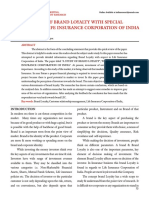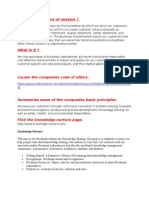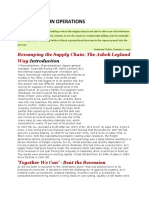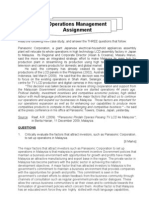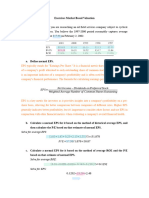Ansoff Matrix: Market Penetration
Ansoff Matrix: Market Penetration
Uploaded by
khairitkrCopyright:
Available Formats
Ansoff Matrix: Market Penetration
Ansoff Matrix: Market Penetration
Uploaded by
khairitkrOriginal Description:
Original Title
Copyright
Available Formats
Share this document
Did you find this document useful?
Is this content inappropriate?
Copyright:
Available Formats
Ansoff Matrix: Market Penetration
Ansoff Matrix: Market Penetration
Uploaded by
khairitkrCopyright:
Available Formats
Ansoff Matrix
To portray alternative corporate growth strategies, Igor Ansoff presented a matrix that focused on the firm's present and potential products and markets (customers). The Ansoff Growth matrix is another marketing planning tool that helps a business determine its product and market growth strategy. Ansoffs product/market growth matrix suggests that a business attempts to grow depend on whether it markets new or existing products in new or existing markets. The output from the Ansoff product/market matrix is a series of suggested growth strategies which set the direction for the business strategy. These are described below:
Market penetration Market penetration is the name given to a growth strategy where the business focuses on selling existing products into existing markets. Market penetration seeks to achieve four main objectives:
Maintain or increase the market share of current products this can be achieved by a combination of competitive pricing strategies, advertising, sales promotion and perhaps more resources dedicated to personal selling Secure dominance of growth markets Restructure a mature market by driving out competitors; this would require a much more aggressive promotional campaign, supported by a pricing strategy designed to make the market unattractive for competitors Increase usage by existing customers for example by introducing loyalty schemes
A market penetration marketing strategy is very much about business as usual. The business is focusing on markets and products it knows well. It is likely to have good information on competitors and
on customer needs. It is unlikely, therefore, that this strategy will require much investment in new market research.
Market development Market development is the name given to a growth strategy where the business seeks to sell its existing products into new markets. There are many possible ways of approaching this strategy, including:
New geographical markets; for example exporting the product to a new country New product dimensions or packaging: for example New distribution channels (e.g. moving from selling via retail to selling using e-commerce and mail order) Different pricing policies to attract different customers or create new market segments
Market development is a more risky strategy than market penetration because of the targeting of new markets. Product development Product development is the name given to a growth strategy where a business aims to introduce new products into existing markets. This strategy may require the development of new competencies and requires the business to develop modified products which can appeal to existing markets. A strategy of product development is particularly suitable for a business where the product needs to be differentiated in order to remain competitive. A successful product development strategy places the marketing emphasis on:
Research & development and innovation Detailed insights into customer needs (and how they change) Being first to market
Diversification Diversification is the name given to the growth strategy where a business markets new products in new markets. This is an inherently more risk strategy because the business is moving into markets in which it has little or no experience. For a business to adopt a diversification strategy, therefore, it must have a clear idea about what it expects to gain from the strategy and an honest assessment of the risks. However, for the right balance between risk and reward, a marketing strategy of diversification can be highly rewarding.
You might also like
- Executive Briefing For The Santa Fe Grill Case StudyDocument10 pagesExecutive Briefing For The Santa Fe Grill Case StudyShadab Qureshi0% (1)
- Inter-Firm ComparisonDocument10 pagesInter-Firm ComparisonMohd sakib hasan qadriNo ratings yet
- Slides of Discovering Statistics Using SPSS by Muhammad Yousaf Abid. Iqra University Islamabad.Document31 pagesSlides of Discovering Statistics Using SPSS by Muhammad Yousaf Abid. Iqra University Islamabad.M Yusuf SlatchNo ratings yet
- Study On Consumer Behaviour and Buying PatternDocument39 pagesStudy On Consumer Behaviour and Buying Patternpradeep_chauhan_20100% (1)
- Marketing Research On AirasiaDocument9 pagesMarketing Research On AirasiaLiew WaiyanNo ratings yet
- Case Analysis Massey Ferguson 1980Document7 pagesCase Analysis Massey Ferguson 1980Muhammad Faisal Hayat100% (3)
- MGT603 Final Term Solved Papers 08 Papers SolvedDocument83 pagesMGT603 Final Term Solved Papers 08 Papers SolvedMurad Khan100% (1)
- Presentation - D Mart Ppt-Roll No 70Document21 pagesPresentation - D Mart Ppt-Roll No 70HARSHAL NAIKNo ratings yet
- A Study On CSR - Overview, Issues & ChallengesDocument14 pagesA Study On CSR - Overview, Issues & ChallengesRiya AgrawalNo ratings yet
- Questionnaire Design and Scale Development: Naresh K. Malhotra, Georgia Institute of TechnologyDocument27 pagesQuestionnaire Design and Scale Development: Naresh K. Malhotra, Georgia Institute of TechnologyratzNo ratings yet
- A Study On Brand Awareness With Special Reference To Sna Oushadhasala Pvt. Ltd. ThrissurDocument55 pagesA Study On Brand Awareness With Special Reference To Sna Oushadhasala Pvt. Ltd. ThrissurT M Jishnu DasNo ratings yet
- A Study On Customer Satisfaction Towards Bajaj Pulsar With Special Reference To Jai Bajaj ChennaiDocument41 pagesA Study On Customer Satisfaction Towards Bajaj Pulsar With Special Reference To Jai Bajaj ChennaiMayurNo ratings yet
- International Human Resource ManagementDocument36 pagesInternational Human Resource ManagementManmeet KaurNo ratings yet
- Topic 5 FORMS OF ORGANIZATIONAL STRUCTURE PDFDocument15 pagesTopic 5 FORMS OF ORGANIZATIONAL STRUCTURE PDFlolipopzeeNo ratings yet
- BCG Matrix Portfolio Analysis Definition: Portfolio Analysis Is An Examination of The Components Included in A Mix of Products With TheDocument6 pagesBCG Matrix Portfolio Analysis Definition: Portfolio Analysis Is An Examination of The Components Included in A Mix of Products With TheJite PiteNo ratings yet
- Unit I Introduction To MarketingDocument12 pagesUnit I Introduction To Marketingsai ramNo ratings yet
- Consumer Behavior ModelsDocument9 pagesConsumer Behavior ModelsShiney RajanNo ratings yet
- Mco 3Document126 pagesMco 3Nija RajuNo ratings yet
- Impact of Information Technology On Productivity: Master'S ThesisDocument136 pagesImpact of Information Technology On Productivity: Master'S ThesisRakesh DhananiNo ratings yet
- Sivas An KaranDocument5 pagesSivas An Karanmohan ksNo ratings yet
- Internship ReportDocument75 pagesInternship Reportgyanprakashdeb302No ratings yet
- STPD by PGDM-03, Welingkar 2013-15Document284 pagesSTPD by PGDM-03, Welingkar 2013-15Varun S Arora50% (2)
- Strategic ManagementDocument24 pagesStrategic ManagementSonetAsrafulNo ratings yet
- BMC Case Study - Vikram V - 18020848018 PDFDocument7 pagesBMC Case Study - Vikram V - 18020848018 PDFVikram VaidyanathanNo ratings yet
- CremicaDocument23 pagesCremicaParitosh SachdevaNo ratings yet
- Titan Advertisement and Sales Promotion StrategyDocument16 pagesTitan Advertisement and Sales Promotion StrategyArpit Jain0% (1)
- MM NotesDocument79 pagesMM NotesDarshan NallodeNo ratings yet
- Report On Marketing Strategy of Rahimafrooz Bangladesh LimitedDocument28 pagesReport On Marketing Strategy of Rahimafrooz Bangladesh LimitedMuntasirNo ratings yet
- Final Project ReportDocument2 pagesFinal Project Reportsyedadil_shahzad3356No ratings yet
- Impact of Dividend On Share Price: Assistant Professor Head of The DepartmentDocument121 pagesImpact of Dividend On Share Price: Assistant Professor Head of The DepartmentBasanth NarasimhanNo ratings yet
- To Study The Impact of The Advertisements On The Brand Preference of consumers-SPSSDocument58 pagesTo Study The Impact of The Advertisements On The Brand Preference of consumers-SPSSUtkarsh AryaNo ratings yet
- Dmba102 Business CommunicationDocument8 pagesDmba102 Business CommunicationShashi SainiNo ratings yet
- Consumer Behavior ProjectDocument48 pagesConsumer Behavior ProjectM Javaid Bokhari100% (1)
- Consumer Behaviour LorealDocument48 pagesConsumer Behaviour LorealPiyush BaidNo ratings yet
- WockhardtDocument69 pagesWockhardtdiyaalkhazraji1290% (1)
- Short Notes On Marketing ManagementDocument63 pagesShort Notes On Marketing ManagementVeeramani Arumugam100% (1)
- Surrogate MarketingDocument18 pagesSurrogate MarketingOnkar KapoorNo ratings yet
- The Notion of DominanceDocument8 pagesThe Notion of DominanceHarshit SinghNo ratings yet
- Targeting Children Is A Sound Business PracticeDocument6 pagesTargeting Children Is A Sound Business PracticeKIRTI PAWARNo ratings yet
- PDF A Project On Marketing Strategy of Big BazaarDocument18 pagesPDF A Project On Marketing Strategy of Big BazaarHarshal Hendre KavinNo ratings yet
- Business Research Methods: Hypothesis TestingDocument31 pagesBusiness Research Methods: Hypothesis TestingChugh RockyNo ratings yet
- Investors Financial Investments Towards Local Chit FundsDocument10 pagesInvestors Financial Investments Towards Local Chit FundsDurai Mani100% (1)
- 11 BibliographyDocument24 pages11 BibliographyMehmudNo ratings yet
- LIC Brand Loyalty PDFDocument16 pagesLIC Brand Loyalty PDFRasika Pawar-Haldankar0% (1)
- Answerkey QP Pre Final October 2019 (Internal Examination)Document7 pagesAnswerkey QP Pre Final October 2019 (Internal Examination)Lipson ThomasNo ratings yet
- Role of HR in Turbulent Times: Chapter-1Document53 pagesRole of HR in Turbulent Times: Chapter-1Hari Naghu100% (1)
- Buckman ReportDocument3 pagesBuckman ReportbharatjaiNo ratings yet
- Parallel Channel EnvironmentDocument2 pagesParallel Channel EnvironmentSaumya SharmaNo ratings yet
- Haldiram Case Study Group 4 Final PresentationDocument7 pagesHaldiram Case Study Group 4 Final Presentationbertilad88No ratings yet
- Personality & Consumer BehaviourDocument27 pagesPersonality & Consumer BehaviourArathy Vikram100% (1)
- SampleDocument42 pagesSampleMeet LalchetaNo ratings yet
- Pharmaceutical IndustryDocument22 pagesPharmaceutical IndustrySelvakapoorNo ratings yet
- Case Studies in OperationsDocument26 pagesCase Studies in Operationssubbalaxmi49No ratings yet
- Mba MarketingDocument130 pagesMba MarketingNa NiNo ratings yet
- Vipul RPR 1Document78 pagesVipul RPR 1Arjun RanaNo ratings yet
- Theories of Retail DevelopmentDocument10 pagesTheories of Retail DevelopmentBen MathewsNo ratings yet
- Green Products A Complete Guide - 2020 EditionFrom EverandGreen Products A Complete Guide - 2020 EditionRating: 5 out of 5 stars5/5 (1)
- Operations Management Assignment: QuestionsDocument7 pagesOperations Management Assignment: QuestionskhairitkrNo ratings yet
- Fundamental of Networking PRESENTATIONDocument11 pagesFundamental of Networking PRESENTATIONkhairitkrNo ratings yet
- Gender Diversity: Week 6 Gopala Sasie RekhaDocument19 pagesGender Diversity: Week 6 Gopala Sasie RekhakhairitkrNo ratings yet
- WALmart CaseDocument2 pagesWALmart CasekhairitkrNo ratings yet
- Creativity and Its Importance in BusinessDocument14 pagesCreativity and Its Importance in BusinesskhairitkrNo ratings yet
- Marketsegmentation 110224234839 Phpapp02Document12 pagesMarketsegmentation 110224234839 Phpapp02khairitkrNo ratings yet
- Lab Exercise 6Document4 pagesLab Exercise 6khairitkrNo ratings yet
- Module 11 Net 2005Document14 pagesModule 11 Net 2005khairitkrNo ratings yet
- Ethic NikeDocument6 pagesEthic NikekhairitkrNo ratings yet
- Worldview High Context and Low Context: by YjDocument14 pagesWorldview High Context and Low Context: by YjkhairitkrNo ratings yet
- The Negotiation Process and International Economic OrganizationsDocument30 pagesThe Negotiation Process and International Economic OrganizationskhairitkrNo ratings yet
- Lab Exercise 5: Pick Your Choice A B Programming NetworkingDocument6 pagesLab Exercise 5: Pick Your Choice A B Programming NetworkingkhairitkrNo ratings yet
- Outsourcing Paper CostingDocument19 pagesOutsourcing Paper CostingkhairitkrNo ratings yet
- Functions of Departments: Unit 1bDocument26 pagesFunctions of Departments: Unit 1bkhairitkrNo ratings yet
- Ethic NikeDocument6 pagesEthic NikekhairitkrNo ratings yet
- Grammar Test 1Document20 pagesGrammar Test 1Harshit SodhaniNo ratings yet
- Task 4Document8 pagesTask 4Anooja SajeevNo ratings yet
- Data City SeedsDocument50 pagesData City SeedsPierre BerthelierNo ratings yet
- CH4 - CH 6 Edited - 2013Document6 pagesCH4 - CH 6 Edited - 2013kirosNo ratings yet
- Assignment Nos. 10 OligopolyDocument2 pagesAssignment Nos. 10 OligopolyCaballero, Charlotte MichaellaNo ratings yet
- Nature of Economic EnvironmentDocument3 pagesNature of Economic EnvironmentWinner ANo ratings yet
- Infinite Horizon Consumption-Saving Decision Under CertaintyDocument13 pagesInfinite Horizon Consumption-Saving Decision Under CertaintyhmmfonsecaNo ratings yet
- Wrigley AnalysisDocument140 pagesWrigley AnalysisBoonggy Boong25% (4)
- TOEFL Intrgtd EssaysDocument3 pagesTOEFL Intrgtd EssaysJohn AllenNo ratings yet
- Exs Market Based Valuation. FINVALDocument17 pagesExs Market Based Valuation. FINVALElena Denisa CioinacNo ratings yet
- Public Finance CourseoutlineDocument13 pagesPublic Finance CourseoutlineDuay Guadalupe Villaestiva0% (1)
- Financial ManagementDocument18 pagesFinancial ManagementLVyNo ratings yet
- 2004 Russell 1000Document6 pages2004 Russell 1000rajeshamexsNo ratings yet
- Dividend FundamentalsDocument2 pagesDividend Fundamentalsmousy_028No ratings yet
- Unit 4-Philosophy of Market ModelsDocument31 pagesUnit 4-Philosophy of Market Modelspriyans100% (1)
- Creating The Problem StatementDocument53 pagesCreating The Problem StatementMohamad NohNo ratings yet
- VMWAREDocument23 pagesVMWARErahul kNo ratings yet
- List of Short-Listed Candidates - 2019 - FinalDocument38 pagesList of Short-Listed Candidates - 2019 - FinalMayank AgarwalNo ratings yet
- Unec 1729708783Document24 pagesUnec 1729708783Narmin AllahverdiyevaNo ratings yet
- The Rationale of New Economic Policy 1991Document3 pagesThe Rationale of New Economic Policy 1991Neeraj Agarwal50% (2)
- Competition, Policy Burdens, and State-Owned Enterprise ReformDocument7 pagesCompetition, Policy Burdens, and State-Owned Enterprise ReformHan WangNo ratings yet
- Atomico Report22 Ready To UploadDocument484 pagesAtomico Report22 Ready To UploadMarcus DidiusNo ratings yet
- Capital Market 2Document25 pagesCapital Market 2manyasinghNo ratings yet
- Quiz 2-1 Mang 2024Document4 pagesQuiz 2-1 Mang 2024Mahmoud KassemNo ratings yet
- ATS Active Trader v2.7 Trading System: TELEGRAM ChannelDocument1 pageATS Active Trader v2.7 Trading System: TELEGRAM ChannelKPH BaliNo ratings yet
- GROUP 6 Galera and Futalan Theory of ProductionDocument24 pagesGROUP 6 Galera and Futalan Theory of ProductionAaron Daniel DuranNo ratings yet
- Mba Syllabus 2009Document49 pagesMba Syllabus 20091231988No ratings yet
- Economic Text BookDocument92 pagesEconomic Text Bookharshal fakeNo ratings yet
- The Ultimate Guide To UK University Admissions Ebook - ID-1Document37 pagesThe Ultimate Guide To UK University Admissions Ebook - ID-1Kadek DiahNo ratings yet











































